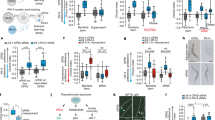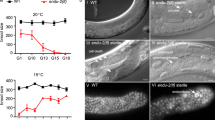Abstract
We expressed SID-1, a transmembrane protein from Caenorhabditis elegans that is required for systemic RNA interference (RNAi), in C. elegans neurons. This expression increased the response of neurons to double-stranded (ds)RNA delivered by feeding. Mutations in the lin-15b and lin-35 genes enhanced this effect. Worms expressing neuronal SID-1 showed RNAi phenotypes when fed with bacteria expressing dsRNA for known neuronal genes and for uncharacterized genes with no previously known neuronal phenotypes. Neuronal expression of sid-1 decreased nonneuronal RNAi, suggesting that neurons expressing transgenic sid-1(+) served as a sink for dsRNA. This effect, or a sid-1(–) background, can be used to uncover neuronal defects for lethal genes. Expression of sid-1(+) from cell-specific promoters in sid-1 mutants results in cell-specific feeding RNAi. We used these strains to identify a role for integrin signaling genes in mechanosensation.
This is a preview of subscription content, access via your institution
Access options
Subscribe to this journal
Receive 12 print issues and online access
$259.00 per year
only $21.58 per issue
Buy this article
- Purchase on Springer Link
- Instant access to full article PDF
Prices may be subject to local taxes which are calculated during checkout





Similar content being viewed by others
References
Fire, A. et al. Potent and specific genetic interference by double-stranded RNA in Caenorhabditis elegans. Nature 391, 806–811 (1998).
Tabara, H., Grishok, A. & Mello, C.C. RNAi in C. elegans: soaking in the genome sequence. Science 282, 430–431 (1998).
Timmons, L. & Fire, A. Specific interference by ingested dsRNA. Nature 395, 854 (1998).
Fraser, A.G. et al. Functional genomic analysis of C. elegans chromosome I by systematic RNA interference. Nature 408, 325–330 (2000).
Kamath, R.S. et al. Systematic functional analysis of the Caenorhabditis elegans genome using RNAi. Nature 421, 231–237 (2003).
Winston, W.M., Molodowitch, C. & Hunter, C.P. Systemic RNAi in C. elegans requires the putative transmembrane protein SID-1. Science 295, 2456–2459 (2002).
Feinberg, E.H. & Hunter, C.P. Transport of dsRNA into cells by the transmembrane protein SID-1. Science 301, 1545–1547 (2003).
Tsang, S.Y., Moore, J.C., Huizen, R.V., Chan, C.W. & Li, R.A. Ectopic expression of systemic RNA interference defective protein in embryonic stem cells. Biochem. Biophys. Res. Commun. 357, 480–486 (2007).
Timmons, L., Court, D.L. & Fire, A. Ingestion of bacterially expressed dsRNAs can produce specific and potent genetic interference in Caenorhabditis elegans. Gene 263, 103–112 (2001).
Tavernarakis, N., Wang, S.L., Dorovkov, M., Ryazanov, A. & Driscoll, M. Heritable and inducible genetic interference by double-stranded RNA encoded by transgenes. Nat. Genet. 24, 180–183 (2000).
Simmer, F. et al. Loss of the putative RNA-directed RNA polymerase RRF-3 makes C. elegans hypersensitive to RNAi. Curr. Biol. 12, 1317–1319 (2002).
Lehner, B. et al. Loss of LIN-35, the Caenorhabditis elegans ortholog of the tumor suppressor p105Rb, results in enhanced RNA interference. Genome Biol. 7, R4 (2006).
Kennedy, S., Wang, D. & Ruvkun, G. A conserved siRNA-degrading RNase negatively regulates RNA interference in C. elegans. Nature 427, 645–649 (2004).
Schmitz, C., Kinge, P. & Hutter, H. Axon guidance genes identified in a large-scale RNAi screen using the RNAi-hypersensitive Caenorhabditis elegans strain nre-1(hd20) lin-15b(hd126). Proc. Natl. Acad. Sci. USA 104, 834–839 (2007).
Wang, D. et al. Somatic misexpression of germline P granules and enhanced RNA interference in retinoblastoma pathway mutants. Nature 436, 593–597 (2005).
Simmer, F. et al. Genome-wide RNAi of C. elegans using the hypersensitive rrf-3 strain reveals novel gene functions. PLoS Biol. 1, E12 (2003).
Sieburth, D. et al. Systematic analysis of genes required for synapse structure and function. Nature 436, 510–517 (2005).
Chalfie, M. & Au, M. Genetic control of differentiation of the Caenorhabditis elegans touch receptor neurons. Science 243, 1027–1033 (1989).
Hardin, J., King, R., Thomas-Virnig, C. & Raich, W.B. Zygotic loss of ZEN-4/MKLP1 results in disruption of epidermal morphogenesis in the C. elegans embryo. Dev. Dyn. 237, 830–836 (2008).
Winston, W.M., Sutherlin, M., Wright, A.J., Feinberg, E.H. & Hunter, C.P. Caenorhabditis elegans SID-2 is required for environmental RNA interference. Proc. Natl. Acad. Sci. USA 104, 10565–10570 (2007).
Jose, A.M., Smith, J.J. & Hunter, C.P. Export of RNA silencing from C. elegans tissues does not require the RNA channel SID-1. Proc. Natl. Acad. Sci. USA 106, 2283–2288 (2009).
Emtage, L., Gu, G., Hartwieg, E. & Chalfie, M. Extracellular proteins organize the mechanosensory channel complex in C. elegans touch receptor neurons. Neuron 44, 795–807 (2004).
Yigit, E. et al. Analysis of the C. elegans Argonaute family reveals that distinct Argonautes act sequentially during RNAi. Cell 127, 747–757 (2006).
Tijsterman, M., May, R.C., Simmer, F., Okihara, K.L. & Plasterk, R.H. Genes required for systemic RNA interference in Caenorhabditis elegans. Curr. Biol. 14, 111–116 (2004).
Ferguson, E.L. & Horvitz, H.R. The multivulva phenotype of certain Caenorhabditis elegans mutants results from defects in two functionally redundant pathways. Genetics 123, 109–121 (1989).
Chalfie, M. & Sulston, J. Developmental genetics of the mechanosensory neurons of Caenorhabditis elegans. Dev. Biol. 82, 358–370 (1981).
Brenner, S. The genetics of Caenorhabditis elegans. Genetics 77, 71–94 (1974).
Hodgkin, J. Male phenotypes and mating efficiency in Caenorhabditis elegans. Genetics 103, 43–64 (1983).
Maduro, M. & Pilgrim, D. Identification and cloning of unc-119, a gene expressed in the Caenorhabditis elegans nervous system. Genetics 141, 977–988 (1995).
Chelur, D.S. & Chalfie, M. Targeted cell killing by reconstituted caspases. Proc. Natl. Acad. Sci. USA 104, 2283–2288 (2007).
Mello, C.C., Kramer, J.M., Stinchcomb, D. & Ambros, V. Efficient gene transfer in C. elegans: extrachromosomal maintenance and integration of transforming sequences. EMBO J. 10, 3959–3970 (1991).
Poyurovsky, M.V. et al. Nucleotide binding by the Mdm2 RING domain facilitates Arf-independent Mdm2 nucleolar localization. Mol. Cell 12, 875–887 (2003).
Frokjaer-Jensen, C. et al. Single-copy insertion of transgenes in Caenorhabditis elegans. Nat. Genet. 40, 1375–1383 (2008).
Acknowledgements
We thank A. Grishok for helpful discussions, J. Kratz for generating the Psng-1yfp plasmid, S. Karimzadegan for generating the Punc-4mdm2∷gfp; Punc-119sid-1 strain. Some C. elegans strains used in this work were provided by the Caenorhabditis Genetics Center, which is funded by the US National Institutes of Health National Center for Research Resources, the C. elegans Gene Knockout Consortium and the National Bioresource Project of Japan. I.T. was supported by an EMBO Long Term fellowship (ALTF 298-2004) and a Human Frontier Science Program Long Term fellowship (LT00776/2005-l/1). This work was supported by US National Institutes of Health grant GM30997 to M.C.
Author information
Authors and Affiliations
Contributions
All authors designed experiments; D.C. generated the initial constructs and constructed the multiply mutant lines; X.C. generated the cell-specific constructs and constructed strains with the sid-1 mutation; A.C., D.C., I.T. and X.C. conducted the RNAi tests; and A.C., I.T. and M.C. wrote the paper.
Corresponding author
Ethics declarations
Competing interests
The authors declare no competing financial interests.
Supplementary information
Supplementary Text and Figures
Supplementary Table 1 (PDF 64 kb)
Rights and permissions
About this article
Cite this article
Calixto, A., Chelur, D., Topalidou, I. et al. Enhanced neuronal RNAi in C. elegans using SID-1. Nat Methods 7, 554–559 (2010). https://doi.org/10.1038/nmeth.1463
Received:
Accepted:
Published:
Issue Date:
DOI: https://doi.org/10.1038/nmeth.1463
This article is cited by
-
Rescue of ApoE4-related lysosomal autophagic failure in Alzheimer’s disease by targeted small molecules
Communications Biology (2024)
-
Autophagy protein ATG-16.2 and its WD40 domain mediate the beneficial effects of inhibiting early-acting autophagy genes in C. elegans neurons
Nature Aging (2024)
-
Cold temperature extends longevity and prevents disease-related protein aggregation through PA28γ-induced proteasomes
Nature Aging (2023)
-
Intermediate filaments associate with aggresome-like structures in proteostressed C. elegans neurons and influence large vesicle extrusions as exophers
Nature Communications (2023)
-
A new AMPK isoform mediates glucose-restriction induced longevity non-cell autonomously by promoting membrane fluidity
Nature Communications (2023)



